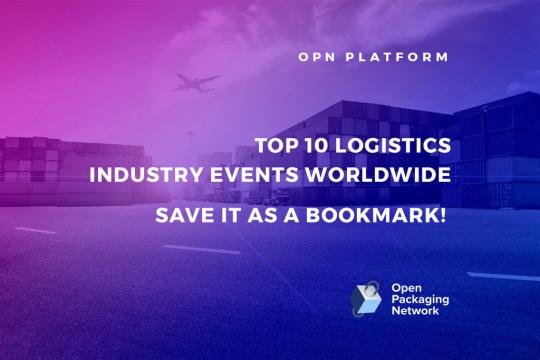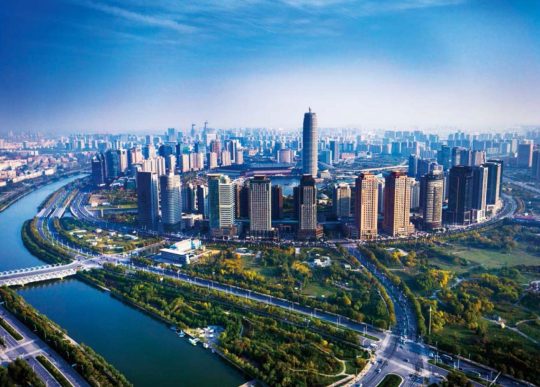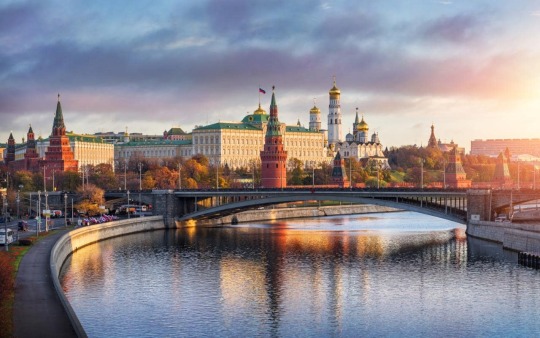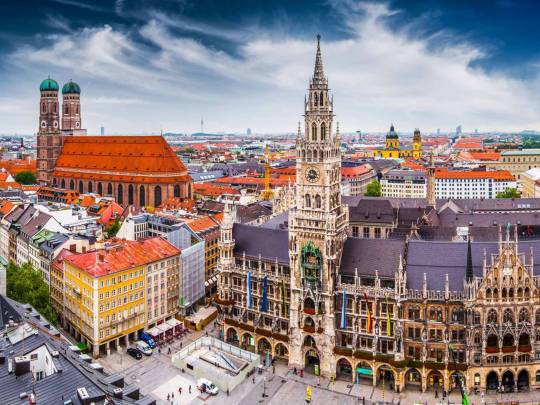Don't wanna be here? Send us removal request.
Text
TOP 10 logistics industry events worldwide. Save it as a bookmark!

Without much words - dictum-factum! We all know how it is important to attend conferences in order to create:
• new working relationships;
• find partners, customers.
It is just a good way to communicate with like-minded people. We have gathered for you the interesting data to get acquainted - here is the list with TOP-10 events that are worth to attend this year. We are ready to these occurrences and advise them to you!
1) Logistics Exhibition 2019
Zhengzhou, China
30.03.2019 - 31.03.2019
http://www.zzwlz.com

At the very beginning of March there will be a great exhibition - it will be useful both for logisticians and e-commerce representatives. We recommend to visit the exhibition to those ones who want to find new partners in Asia, as well as to learn how the industry works in this market.
2) Intralogistics Europe 2019
Paris, France
26.03.2019 - 28.03.2019
https://www.sitl.eu/le-salon/les-secteurs/

This is the most important event in European logistics. The european occurrence combines all innovative products and services designed for freight, freight forwarding and supply chains. This is the place of the huge concentration:
• of transport
• of logistics users.
Here are all the industry, commerce and distribution representatives who are looking for new suppliers.
3) Hannover Messe 2019
Hannover, Germany
01.04.2019 - 05.04.2019
https://www.hannovermesse.de/

Look at the industry from a technological point of view. Researching, development, industrial automation, implementation of information technology - all these aspects are presented here.
4) TransRussia / TransLogistica 2019
Russia
15.04.2019 - 17.04.2019
http://www.transrussia.ru/ru-RU/

The largest logistics services exhibition in Eastern Europe - is considered as the really good place to get new business connections.
5) Intertraffic China 2019
Shanghai, China
22.05 -24.05
https://www.intertraffic.com/china/

The world's largest traffic and mobility technology event in China. It will be interesting for everyone. There are presented many technological devices and solutions that are applicable in different areas.
6) Transport logistic 2019
Munich 04.07- 07.07
https://www.transportlogistic.de/index-2.html

And welcome to Germany once again! This event is the world's leading trade fair for logistics, mobility, IT and supply chain management. Here the industry solutions and modern technology are presented .
7) ACSM 2019
Las Vegas
16.09 - 18.09
http://www.apics.org/annual-conference/about/ascm-2019/

Want to find your bearings in business? Namely here you can expand your knowledge and skills, learn more about automation and robotization of the processes, chat with other professionals in the field.
8) RoboBusiness 2019
Santa-Clara
01.10 - 03.10
https://www.roboticsbusinessreview.com/event/robobusiness-2019/

Forward step to the future in the form of the possibility to learn more about the robotization of processes in the field of logistics and other areas. All these opportunities are waiting for you at RoboBusiness 2019
9) Automation Fair 2019
Chicago
20.11 - 21.11

Automation, automation and automation once again! It will be useful for engineering industry representatives and for logistics exponents.
10) Pacprocess MEA
Cairo, Egypt
December 9-11
http://www.pacprocess-mea.com

For starters, it will be very warm there. Secondly, the event will be really useful for all representatives of the packaging industry.
0 notes
Text
Logistic systems

The most common definition in the literature is the following one: “A logistic system is an adaptive system with feedback that performs certain logistic operations and functions. It, as a rule, consists of several subsystems and has developed connections with the external environment. ”
As a logistics system, one can consider an industrial enterprise, a territorial production complex, a trading enterprise, etc. The purpose of the logistics system is to deliver goods and products to a specified place, in the right quantity and assortment, as much as possible prepared for production or personal consumption. a given level of costs.
Logistics sets and solves the problem of designing harmonious, coordinated material-conducting (logical) systems, with the given parameters of the material flow at the output. In order for the system to exist, develop, improve, and survive in extreme conditions, it must have a combination of certain properties. We characterize the properties of logistic systems in the context of each of the four properties inherent in any system:
Integrity and articulation
A system is an integral set of elements interacting with each other. At the macro level, during the passage of the material flow from one enterprise to another, these enterprises, as well as the transport connecting them, can be considered as elements. At the micro level, the logistics system can be represented as the following subsystems:
Procurement - a subsystem that provides the flow of material flow in the logistics system.
Production planning and management - this subsystem takes the material flow from the purchasing subsystem and manages it in the process of performing various technological operations, turning the subject of labor into a product of labor.
Sales - a subsystem that ensures the disposal of material flow from the logistics system
As we can see, the elements of logistic systems are of varying quality, but at the same time compatible. Compatibility is ensured by the unity of purpose, which is subject to the functioning of logistics systems.
Connections
There are significant connections between the elements of the logistic system, which, with a legitimate need, determine the integrative qualities. In macrological systems, the basis of communication between the elements is a contract. In micrological systems, the elements are interconnected. Links can be real, informational, direct, inverse, etc. The connections between the elements must be more powerful than the connections of the individual elements by the external environment because otherwise, the system cannot exist.
Organization
The links between the elements of the logistics system are ordered in a certain way, that is, the logistics system has an organization. The presence of system-forming factors in the elements of the system only suggests the possibility of its creation. For the appearance of the system, it is necessary to form ordered links, i.e. the certain structure of the organization of the system.
Integrative qualities. The logistic system has integrative qualities that are not peculiar to any of the elements separately. This is the ability to deliver the right product, at the right time, at the right place, of the required quality, with minimal costs, as well as the ability to adapt to changing environmental conditions.
Types of logistic systems
Logistics systems are divided into macro-and micrological. The macrologistical system is a large material management system, covering industrial enterprises and organizations, intermediary, trade, and transport organizations of various departments located in different regions of the country or in different countries. A macrologistical system is a specific infrastructure of an economy in a region, country, or group of countries.
When forming a macrologistical system covering different countries, it is necessary to overcome the difficulties associated with the legal and economic features of international economic relations, with different conditions for the supply of goods, differences in the transport legislation of countries, as well as a number of other barriers.
The formation of macro logistical systems in interstate programs requires the creation of a single economic space, a single market without internal borders, customs barriers to the transportation of goods, capital, information, and labor resources.
Micrologistical systems are subsystems, structural components of macrologistical systems. These include various industrial and commercial enterprises, territorial-industrial complexes. Micrologistical systems are a class of internal logistics systems, which include technologically related production, united by a single infrastructure.
Within the framework of macrologistics, the links between individual micrologistical systems are established on the basis of commodity-money relations. Within the micrologistical system, subsystems also function.
Thus, as a result of the study, the following conclusions can be made: the use of information logistics systems has allowed for effective communication between the participants in the management process, although this has led to some problems, for example, the lack of information gathering at the enterprise, technical support at enterprises, etc.
Currently, these problems are at the decision stage, since the role of information support of logistics management is increasing every day, acquiring a massive scale, thereby accelerating the process of formation of information systems in logistics.
0 notes
Text
Cargo Transportation: How it Works?

If you decide to open your own business, then you can turn your attention to such an area in the business as cargo transportation.
This is a great idea to start with. After all, it is not necessary to spend money immediately on the goods and it will not take long before the first profit.
And do not be afraid of the global crisis and the closure of many firms. This happens for various reasons. Some companies simply do not have means of subsistence, while others lose customers and, accordingly, sooner or later go bankrupt.
The idea can even be called the meaning of your business. Therefore, before choosing a business idea, you need to carefully figure everything out and think it over.
To do this, it is necessary to clearly outline the goal of the project - the creation of an enterprise whose main activity will be the provision of cargo transportation services on medium commercial transport.
Enterprise services are primarily focused on demand from the public. And this demand always exists, since there will always be someone who needs to bring or take something.
Any business should start with an analysis of the relevant market segment. It is necessary to find out information about who is engaged in transportation, how much the market occupies, what machines it uses, what goods it transports and what its price policy is.
An analysis of the information obtained will show whether the services of your enterprise will be in demand or whether the market is already sufficiently filled with carriers.
After that, you need to make sure that potential customers know about you. Be sure to include in your plan item on the placement and dissemination of promotional materials.
How to please a client?
Often, customers are not very happy with the fact that in reality, the transportation of goods is much more expensive.
Sometimes there are cases when the movers specifically invent additional conditions that are subject to additional payment: extra kilometers, floors, etc.
To organize a business of a decent level, one needs to create an alternative to such dubious services, which will be opposed to poor quality and cheap transportation.
Currently, there are dozens of companies involved in cargo transportation. Open Packaging Network is a platform which can make this process even easier. It is a fair marketplace where services are provided as per promises and agreements between buyers and sellers, an open platform for online reliable, fast and transparent transaction. Sellers and buyers are, indeed, able to publish services and products they provide or need, interact with each other get fulfilled from the counterparty.
0 notes
Photo

#OPN team has many news to tell you about team members, project concept and interesting stories which constantly happen while working. Write back, what do you want to know, what posts will be interesting for you.
0 notes
Photo

Are you fruit lover? Is your family fond of fruit salads and support the idea of healthy lifestyle? #OPN presents fresh idea of citrus packaging. Like it? http://amp.gs/VhgZ
0 notes
Text
Shipping and fulfillment

The most important functions in procurement logistics are shipping and fulfillment.
The processes consist in tracking the movement of material flows, starting with confirming the sources of generation of receipt of an order, agreeing on the terms of delivery and completing the verification of shipment and delivery of the ordered products. In the course of monitoring the fulfillment of the order, the supplier’s compliance with his contractual obligations on the assortment structure, material flow rate, and product quality is checked. The control function performed at the enterprise allows regulating the intensity of material flows and making conclusions about the reliability and responsibility of the supplier.
Unforeseen supply disruptions may lead to a temporary halt in production or a reduction in production volumes. With a proper organization of control, the company will be able to promptly receive information on the volume and timing of the expected supply of goods and promptly take appropriate measures when possible deviations from the conditions of the order.
The logistical system for monitoring the implementation of the order provides for direct permanent contact between the sender and the recipient of the goods. This interaction is mutually beneficial, as it allows to identify shortcomings in the work of the supplier, and for the consumer to have a reliable supplier that allows the company to operate without failures. With this interaction, arrays of information are formed on the parameters and structure of material flows, on the development of business relationships with suppliers.
As a rule, the control system installed at the enterprise is designed not only for observing the conditions of the order, but also for detecting defects at the initial stage, thus avoiding the ingress of poor-quality raw materials and materials into the production process. The direct interdependence between the quality of raw materials and finished products makes entrepreneurs pay increased attention to the quality of raw materials.
The complexity of monitoring the implementation of the order is due to the nomenclature, the range of supplied goods. The wider the range, the more time will be spent on checking the shipment of goods delivered. A consignment of goods is a volume and assortment of a one-time delivery of products regulated by a contract. The formation of a consignment of goods occurs on the basis of the customer’s need for specific material flow.
The parameters by which the recipient company will monitor the implementation of the order entirely depends on the enterprise itself. As a rule, the list of requirements for the batch of goods is formed on the basis of production needs, due to the final product and process. On the other hand, the delivery schedule depends on the supplier’s ability, the type of transport used, the storage conditions of the product and many other factors.
For example, if an enterprise produces disposable plastic products, then the raw materials obtained for production - plastic must be intended for food products and have a corresponding certificate. The company uses machines that work on raw materials of a certain shape and weight. Otherwise, the company needs to have a special unit that specializes in preparing raw materials of the desired shapes and sizes or look for an intermediary specializing in the performance of these functions.
When placing an order and its implementation, the consumer must necessarily agree with the supplier of material flow intervals. If the shipping interval is a reference for the supplier, then the delivery interval is a reference for the consumer.
Nowadays, there are lots of companies, which promote their shipping offers. However, one cannot trust all of them. Open Packaging Network is the one with years of experience in the packaging industry. It aims to provide a seamless system for real time confirmation of transactions along with a slew of tools and 3rd party integrations.
Want to know more?! Follow our Telegram channel: https://t.me/OpenPackagingNetworkOFFICIAL
0 notes
Text
Today’s logistics. Are there more problems than solutions?

Today, not only teachers and scientists are interested in logistics, but also business leaders, industrialists, and engineers. Logistics is an integrated activity that extends from the beginning of the production of goods to the consumption of goods by the buyer.
From a business point of view, logistics is the process of efficiently managing material flows in achieving its goal with optimal costs for all resources. In a number of most foreign countries, where logistics has been intensively developed over the past two decades, a number of periodicals in various areas of logistics are already in place and have an efficient functioning of the logistic association.
At that time, such modern concepts and technologies as “Integrated Supply Chain Management”, “Lean Production”, “E-Logistics”, etc. appeared.
The development of the transport system is of great importance. Transport, in its meaning, is one of the tools in achieving social well-being, economic and foreign policy, and goals. In terms of modernity, transport is one of the determining and guiding factors in increasing economic growth. At the moment, the transport system in the demand for the transport of passengers and goods satisfies the consumer market. Since the beginning of 2000, the growth of transport services on average per year has been 3.8% for freight traffic, and 6.7% for passenger traffic, with an average annual growth of the economy about 6.1%. With all this, the growth of transport services is unevenly distributed between different types of transport. This is due to the problems of development of individual modes of transport and significant regional unevenness.
In recent times, today's logistics concepts have been quite successfully applied by domestic companies, both in strategic and operational management of the main business areas. The modern mechanism of logistic management allows increasing the business sustainability of the company in the market. Logistics is a kind of concept in the business environment, which is based on attracting separate and interrelated elements into one general process with a specific goal in preventing the irrational and inefficient use of all the resources of a company. Logistics in practice is considered as one of the business tools that allows saving company resources. The main of the main tasks in logistics is to optimize internal and external material flows, as well as information and financial flows associated with them, in order to minimize total costs. Interest in the field of logistics development in developed countries has historically been associated primarily with the economic nature. In conditions when the growth of production volumes and expansion of intra-national and micro-economic ties led to an increase in costs in the sphere of circulation, the attention of entrepreneurs focused on finding new forms of optimizing market activity and reducing costs in this area.
The uniqueness of logistics lies in the fact that, acting as a sphere of material production, it simultaneously performs the auxiliary function of the serving infrastructure. Often the role of logistics is underestimated, keeping silent about its most important role in the field of economics. The logistic factor is necessarily taken into account when placing production in a particular region, it is one of the most important. The national economy annually suffers losses due to disproportions in the technical armament of various types of transport, and especially between the level of development of permanent structures and the rolling stock, for example, between the capacity of stations and the number of wagons; bandwidth of lines and density of movement of transport units; length of roads and the number of cars to them.
However, nowadays, lots of problems the logistics industry faces can be solved. Open Packaging Platform can help in this regard. The OPN ecosystem is a marketplace for Sellers and Buyers to interact with each other. Sellers and Buyers can both publish the products that they have and need respectively and get it fulfilled from the counterparty. The ecosystem is designed to act as a one-stop solution for all packaging related services.
Read more by following our Telegram channel: https://t.me/OpenPackagingNetworkOFFICIAL
0 notes
Text
Packaging industry: history and future

Like everything in this world, the packaging industry also has a history.
To understand how this industry will develop, one needs to go into its past.
In the XX century. polymeric materials were widely used as packaging materials.
In the last decades of the same century, food began to be in great demand among the population, ready-to-eat or in the form of convenience food in portioned packaging, which is also a dish. A wide variety of packages are created with various functional devices that protect against forgery, unnoticeable use of the contents, made with protection against opening by children, etc.
As a result of centuries-old evolution, packaging has become an object that a person encounters throughout life, and the packaging industry is now a powerful independent industry, in terms of production volumes and the number of people employed in it competing with leaders such as the military-industrial and agro-industrial complexes.
Modern packaging industry binds together the most diverse areas of production, trade and consumption. It has become one of the most important links in the global industrial infrastructure and is developing intensively on the basis of scientific and technical achievements.
At the same time, the growth of packaging production in quantitative terms does not exceed the growth of the gross national product. However, this does not mean that the packaging sector has reached the peak of its development - only qualitative changes have occurred in its structure.
Currently, the range of domestic packaging production includes dozens of plastic packaging, plastic packaging for food, household chemicals, medical and cosmetic products, as well as film materials of various composition and purpose with a wide range of consumer properties. The relative simplicity of technological processes and the comparative availability of standard equipment for the manufacture of these types of packaging make it possible to adjust their production not only at manufacturing enterprises, but also at consumer enterprises.
The fast-growing packaging industry unites the efforts of suppliers of raw materials, manufacturers and sellers of finished products.
At present, not all enterprises have free working capital to invest in the packaging business and ensure future income. According to experts, the potential demand in the packaging market is 1.5–2 times higher than the actual solvency of customers. Therefore, the majority of producers are forced to use different types and means of packaging, as well as packaging materials without taking into account the specific properties of products, thereby violating the requirements of existing standards. All this leads to huge losses and damage to goods.
Thus, modern packaging is a mandatory component of a developed economy. It contributes to the development of high-quality products, rationalization of their production and distribution, facilitates marketing activities and the implementation of logistics operations, ensures the competitiveness of products. The condition of the package and its quality characteristics are to certain extent indicators of a production culture. Considering the problems of the packaging industry, one cannot ignore the issues of waste disposal, which arise due to the limited raw material resources. First of all it concerns waste paper, glass containers, bottles of polymeric materials.
However, nowadays, thanks to new technologies, particularly blockchain, people can use packaging industry more efficiently. Open Packaging Platform gives such a chance.
A platform is an open architecture, together with a governance model, designed to facilitate interactions. It allows 3rd parties to participate, to build, and to innovate in standardized ways. In addition, OPN provides the means by which value is created. By interacting with other people, with content, or with products and services, people who use the platform should experience a form of personal gain.
Follow our Telegram channel for more news: https://t.me/OpenPackagingNetworkOFFICIAL
0 notes
Text
Practical applications of Blockchain technology

The decentralized electronic data storage system or simply blockchain was originally used to create and mine cryptocurrencies. But technology can be applied not only in this area: its security and transparency are useful in any activity where there is a great risk of fraud and errors in the transmission of information.
A decentralized database consists of a sequence of transactions, information about which is stored simultaneously on multiple computers in different parts of the world. It is impossible to falsify or delete such information: it is this feature that makes blockchain technology so promising for use in medicine, logistics, data management, government, and many other areas of regulation. However, we will focus more on the logistics side.
It can be said that there are no more coinciding branches than logistics and blockchain. Sharing these technologies allows to securely manage anything. Blockchain technology allows to get rid of all the problems that accompany the logistics industry for many years, because it is a transparent and public register that provides customers with a convenient and fast way to track the route.
In addition, thanks to this technology, many advantages can be brought to the industry:
Elimination of unnecessary intermediaries;
Reducing the volume of workflows;
Ensuring reliable protection;
Reducing the number of possible errors (or even eliminates them completely);
Preventing fraud and illegal trade;
Providing huge savings for the whole industry.
There are already proofs of introducing blockchain to logistics. Experience of 2016 is a vivid example. The Commonwealth Bank of Australia and Wells Fargo made the first major trade deal, using smart-contracts and blockchain. The transaction was carried out in payment for the shipment of cotton from the USA to China for 35 thousand dollars. Then, the Port of Rotterdam made another similar deal, and after that, such transactions through the blockchain has become quite common.
One more example where blockchain fits well is the Open Packaging Platform. This is a marketplace for sellers to find their buyer counterparts and vice versa. The Open Packaging Network aims to provide a seamless system for real-time confirmation of transactions along with a slew of tools and 3rd party integrations.
More information on the official Telegram channel:
https://t.me/OpenPackagingNetworkOFFICIAL
0 notes
Text
Token as a platform management tool. Ease of cryptocurrency usage.

A token is a standard unit of measure issued for an ICO asset. All ICOs issue a unique digital asset (tokens), which investors receive in exchange for their cash or cryptocurrency investments. In fact, people buy virtual tokens to receive internal company services or for later exchange at a more attractive rate.
Thus, a token is a product or service, a benefit that a company offers after ICO. In some cases, this asset may become a cryptocurrency, if that was the original purpose of the primary placement of coins. However, in essence, this is a difference between a token and digital coins. The coin is cryptocurrency and cannot perform a different role, except as a means of payment. The role of the token is much broader. It can act as a virtual currency, as the right to unique content or service of a company, or perform another symbolic, but similar function.
The difference between a token and cryptocurrency
Cryptocurrency is a virtual currency that is protected by cryptography and is based on blockchain technology. Cryptocurrency can be mined using special technological equipment. People who focus on mining are called miners. That is, miners, roughly speaking, release cryptocurrency. In general and in general - this is a digital-analog of money.
A token is a virtual unit of expression of value, a medium of exchange for goods or services and obligations in a digital format. It is also based on the blockchain technology, but it cannot be mined.
A token does not have its own blockchain and can be issued centrally and decentralized. The value of tokens depends on the market value, but the pricing is influenced not only by the balance of supply and demand but also by binding to a particular asset.
The similarity of cryptocurrencies and tokens in that both can be used as a digital currency. The methods for transferring and storing tokens are almost identical to the transfer and storage of cryptocurrency coins. However, as a rule, wallet applications are on the platform that conducted the ICO. Cryptocurrency can be stored in independent wallets of different projects and companies.
Let’s take into account tokens of Open Packaging Network. It is the open source platform, a decentralized ecosystem for high growth packaging industry participants and related services. The platform uses the OPN token. It is the official currency for buying and selling and has a shared stake. Customers will be able to use their OPK token as collateral to secure loans for their business.
0 notes
Text
The advantages of investing in blockchain-based projects
The only secure way to bet on the blockchain is not entirely dependent on the success of the technology.

Almost a decade has passed since bitcoin and its underlying distributed registry technology, or blockchain, appeared, but the real cryptocurrency boom began only in 2017.
Blockchain allows to register transactions without centralized regulators. Theoretically, with the help of the blockchain, any process that involves the interaction of various parties and intermediaries can be made much more efficient. Bitcoin and other cryptocurrencies are trying to become such a solution in the market for mutual settlements, but this is just one of many possible applications of technology.
How to bet on blockchain
In essence, for an investor who wants to bet on the blockchain, there are two main options. You can invest in the purchase of cryptocurrency, such as Bitcoin or ether. The cost of bitcoin in 2017 has risen from about $ 1,000 to more than $ 13,000. Dollars. The rate of air for the same time increased from $ 10 to more than $ 700. So this strategy certainly works - in any case, it worked last year.
The problem is that while you are not investing in the blockchain, you rely on its specific use. In order for your investment to pay for itself in the long term, two conditions must be met. Firstly, the blockchain technology itself must meet expectations and gain a foothold in various markets; secondly, a particular cryptocurrency should become a really useful tool - because now its assessment remains almost exclusively speculative.
In this case, it may well be that the blockchain will receive universal acceptance and will be widely used in various industries, and cryptocurrency will not withstand the test of time and lose all value.
There is another obvious way to bet on the blockchain: to invest in companies using this technology.
Investing in companies that use blockchain is a more reliable option than buying cryptocurrencies, but it is very important to choose the right company.
There are lots of blockchain startups now, however only a few of them are worth investing in. Open Packaging Network is the example of such. It is a blockchain-based project whose goal is to provide transparency in the packaging industry by creating a platform that uses technology to provide value to industry stakeholders.
Follow the official Telegram channel to stay tuned: https://t.me/OpenPackagingNetworkOFFICIAL
0 notes
Text
We continue our meeting with OPN members
As the global packaging industry keeps growing, more and more people want to know how to benefit from it. We asked some questions to the team and got their opinions.

Oleksandr Suschenko who is in charged of the marketing side gave his thoughts about the overall aim of the platform.
— The overall aim is to create a fair marketplace for logistics businesses. The technology behind is based on the blockchain, which allows to conduct fast and transparent transactions and cooperate with trustworthy partners all over the world, with any time-consuming phone calls and personal agreements.
Elena Antonova, who is a PR manager also shared her opinion on that issue.
— The OPN platform is intended to create the fast, reliable and open marketplace for the logistics industry. Based on the blockchain, the technology will allow its stakeholders ( packaging and delivery providers, manufacturers, payment and logistics companies) cooperate within one platform without wasting time on trusted providers research, tracking and payment methods.
— What are the partners of OPN?
Elena Antonova: ’’Plastic Manufacturers: plastics, glass, metal, paper; Packaging Fulfilment companies; Material Handling companies; Design & Branding companies, Local Distributors; Finance providers; P2P Lending providers; Payment service providers; Credit solution providers; Label printing companies; Marketing Agencies; Logistic & Shipping companies’’.
Serhii Tabachnyi who is the Youtube manager replied about the usage of blockchain within OPN
— If blockchain technology allows us to more securely and transparently track all types of transactions, imagine the possibilities it presents across the supply chain.
— When are you planning to launch a full functioning platform?
Oleksandr Suschenko: ‘’January 10th the latest’’.
— Which new features are you going to implement in OPN in terms of packaging industry?
Elena Antonova: ‘’I'm not sure I'm going to implement something in terms of the packaging industry. But definitely, my core task is to build a solid brand reputation on the packaging market, as well as establish trustworthy relations between OPN business and its clients’’.
0 notes
Text
Blockchain and crypto event calendar for 2019
Despite the fact, that cryptocurrency market did not show growth as it was in 2017, however, there were many events devoted to the blockchain. The upcoming 2019 supposedly will not be less interesting. In this regard, we will cover a few events, which will shake the crypto-industry.

The first major event entitled Unlock conference will be in Dubai, 15-18 January. The organizers are proud that the second such conference will take place in Dubai.
Dubai and the UAE are pioneers in using the blockchain as a means to create more efficient and optimal public services. Today, 20 blockchain case studies are conducted in Dubai, and the UAE has already developed a strategy according to which by 2021 50% of public services will be transferred to the blockchain.
Another event, which will take place also in January is the blockchain conference EmTech Asia in Singapore. EmTech is a place where technology, business, and culture come together. At the conference, you will meet innovators, academics, investors and technical managers who set the stage for the next technological revolution.
Organizers believe that innovation occurs at the intersection of different disciplines. To this end, they unite the brightest minds in artificial intelligence, materials science, biomedicine, the media, and many other areas to share the latest research and discoveries.
One more event which is prominent for the blockchain industry will take place in February. That is the Global Digital Forum in the USA. It is a global technology conference that was designed in a unique way to bring together business leaders, practitioners and customers from around the world who are working on artificial intelligence, blockchain, cloud services and the Internet of things.
Besides, regular forums, there will be some specific ones dedicated to particular issues within blockchain. Crypto Games Conference is the example of such. In April Minsk will host:
• 1000+ professionals from more than 30 countries;
• More than 100 speakers;
• Sessions for startups and investors;
• Two-day blockchain gaming hackathon.
These are just a few events which will occur in 2019. Stay tuned with us to know about other blockchain conferences.
0 notes
Text
OPN year 2018 wrap up + plans for 2019
2018 is coming to the end and we need to sum up the achievements of the outgoing year.

First of all, we have started the ICO campaign and successfully launched the MVP, where users can check the functionality of the platform.
Secondly, we have gathered experienced team members and advisors who are competent in logistics and blockchain and who have years of working for different global companies.
Thus, the team with its CEO has promoted the company by different means, explaining how blockchain can improve the packaging industry. As the example, we were at the Malta Blockchain Summit, where introduced the platform and its features.
Besides that, we have partnered with some major players in the industry. The first one is the European Association of Intelligent Packaging. AIPIA believes that the implementation of new technologies in packaging is key to growth, secures protection, enhance efficiency.
Another partner is Trace Alliance, an association of organizations working together to solve supply chain challenges using the Origin Trail blockchain protocol.
However, we do not stop in our development. We are always negotiating with different partners in the sphere of shipping and doing our best. In addition, the already working platform is about to be launched in January, and clients can sign up and try our seamless system for real-time confirmation of transactions along with a slew of tools and 3rd party integrations.
We believe in the power of blockchain technology to transform the packaging space for the better. To that end, our solution is designed to leverage the advantages of this technology to provide value to the stakeholders of the ecosystem.
Stay tuned with our Telegram channel https://t.me/OpenPackagingNetworkOFFICIAL
0 notes
Text
Blockchain &GDPR - an Unlikely Match
The General Data Protection Regulation (GDPR), which entered into force in May of this year, is primarily aimed at enabling EU citizens to know how information about them is processed. According to the regulations, people have the right to request that their personal data be corrected or deleted.

On the other hand, there is a blockchain - a technology that creates what is called the immutable registry. The blockchain makes it very difficult to change or delete any information stored in it.
The fundamental principles of the GDPR and blockchain are in conflict with each other. GDPR requires adjustability, blockchain provides consensus. A difficult situation arises, which in realities of the GDPR raises the question of whether companies using blockchains for processing personal data in the EU should stop providing their services.
On the one hand, the blockchain responds with one of the main messages of the GDPR - with the help of it, the information becomes transparent and open. Due to the fact that the blockchain is a distributed registry, it provides protection against illegal access to data that is inaccessible for control of those in power. But, on the other hand, it will be rather difficult to provide users with the “right to oblivion”. Now blockchain startups have only one thing left, if they want to continue to cooperate with Europeans and not pay huge fines, to store personal data outside the blockchain.
Another cause for concern was the regulatory uncertainty associated with raising funds through the ICO.
In April of this year, the UK Financial Supervision Authority announced its intention to adopt a regulation on the ICO, but so far no explanation has been published on this matter. This impedes plans that some ICO projects might have. It is difficult for firms that have digital assets to open a bank account, despite the fact that investors are taking all the necessary measures to combat money laundering and comply with the KYC procedure.
However, despite that fact, now there are ICOs which offer KYC/AML policy to customers.
Open Packaging platform is the example of such a startup. With the help of blockchain technology, the project plans to disrupt the packaging industry with world’s first decentralized marketplace for sellers and buyers, delivery agents, validators, suppliers and other ecosystem participants. In order to take part in the token sale, clients first need to undergo KYC regulations. That is done in order to make the process transparent and legal. More information about Open Packaging Network is on its Telegram channel: https://t.me/OpenPackagingNetworkOFFICIAL
0 notes
Text
OPK Token listed on EtherMium DEX - and other decentralized exchanges
Dear friends,
OPK Token is listed on DEX Ethermium.com. EtherMium is the first decentralized exchange to offer STOP-LIMIT and MARKET order types with more than 1100 tokens trading on our exchange.
https://ethermium.com/t/Open%20Packaging%20Network-OPK

Thus, OPK Token signed an agreement with Bancor, largest decentralized exchange in the world. In January, 2019, upon completion of OPN Crowdsale, OPK Token will be officially up for sale on Bancor exchange. Follow our Telegram channel for more news: https://t.me/OpenPackagingNetworkOFFICIAL
0 notes
Text
KYC and AML usage in cryptocurrencies and ICO
What are these words KYC & AML and what are they connected with?

Firstly, this abbreviation is from the already well-known in the foreign law phrases "Know Your Customer" and "Anti-Money Laundering".
Secondly, their abbreviated use is generally accepted and is found wherever there are legal restrictions (or requirements) related to state control in relation to business entities. That is, where there is a legal relationship, a kind of customer-firm-state chain.
Most often this can occur under licensing requirements set by the licensor to such an enterprise when obtaining, for example, a financial or gambling license, when not only electronic, but also fiat money is in circulation.
Following the new trends in this field, a new coin called AML Bitcoin has appeared on the cryptocurrency market. It was developed taking into account the KYC & AML policies and the requirements of the Patriot Act (USA), as well as issued with the approval of the organization "NAC Foundation", a member of "ABA" - the American Interbank Association.
The causal introduction of CIS and AML in a cryptocurrency environment was the demand for instant in-out cryptocurrency in conjunction with fiat money. It is about both cash and non-cash form, including the use of such most popular payment instruments like Visa and MasterCard, SWIFT payments and so on.
Previously, most users had inconvenience for the sake of anonymity, turning to exchangers for withdrawal of cryptocurrency in real money as a last resort, then in today's reality, when the speed of transactions and the efficiency of the cash-out is at the forefront, activity confirmed the need to introduce financial innovations, albeit to the detriment of anonymity, but in favor of their own security.
In the case of verification of the identity and the passage of all KYC & AML procedures, the attacker can no longer easily steal your hard-earned "coins" by pushing large sums at least into limits and, as a maximum, into requirements for additional re-verification. Moreover, it should be noted in a separate line that some online wallets, after having passed the verification of their clients (sometimes without fail, and sometimes as a separate security measure), establish the so-called 2F authorization.
What to prefer: anonymity or security - the personal choice of each. In any case, when choosing online wallets and exchange services. These are the realities and new rules of the game in the field of jurisdictions of the European Union and the United States, which are increasingly tightening the requirements for their citizens and legal entities.
KYC and AML practices are being introduced not just into cryptocurrencies but ICO as well, because lots of projects unfortunately, are scams. However, there are platforms with such features. Open Packaging Network is a vivid example. It is a blockchain-based project whose goal is to ensure transparency in the packaging industry by creating a platform that uses technology to provide value to industry stakeholders. Stakeholders do not need to worry about who they trade on the platform with, since using Know Your Customer (KYC) and Anti-Money Laundering (AML) helps identify parties. Follow our Telegram for more news: https://t.me/OpenPackagingNetworkOFFICIAL
0 notes